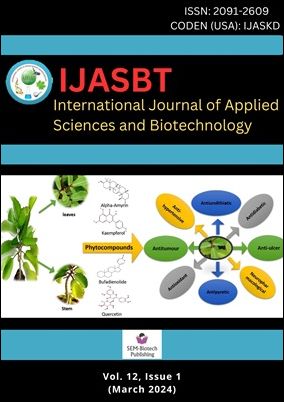Assessing the Clinical Outcomes of Voxelotor Treatment in Patients with Sickle Cell Disease
DOI:
https://doi.org/10.3126/ijasbt.v12i1.64057Keywords:
Hemorheology, Rheological properties, Vaso-Occlusion, Viscoelasticity, Hemoglobin polymerization, Deformability, Endothelial interaction, Computational modeling, VoxelotorAbstract
The results of Voxelotor treatment in Sickle Cell Disease, as assessed through clinical outcomes, demonstrated its efficacy in reducing hemolysis and improving hemoglobin levels. This effect can be attributed to Voxelotor's inhibition of HbS polymerization, thereby restoring the deformability and compliance of sickle RBCs. Our mathematical model provided mechanistic insights into how altered rheological properties of sickle RBCs impact their flow dynamics in microcirculation. Specifically, we observed that Voxelotor-induced improvements in RBC deformability and compliance lead to enhanced plasma film height in capillaries, promoting smoother blood flow and reducing the risk of vaso-occlusive events. We established a direct relationship between the molecular mechanism of Voxelotor action and its clinical outcomes. The mathematical model served as a bridge, elucidating how Voxelotor-induced changes in sickle RBC mechanics translate to improved microcirculatory flow and reduced vaso-occlusion. This holistic understanding not only validates the therapeutic efficacy of Voxelotor but also underscores the importance of considering biomechanical factors in evaluating treatment outcomes in SCD. Furthermore, this study highlighted the relevance of microfluidics based diagnostic tools in assessing the efficacy of Voxelotor treatment. By leveraging insights from our mathematical model, microfluidics devices can be designed to mimic physiological conditions and effectively evaluate the deformability of sickle RBCs before and after treatment. This integrated approach not only facilitates the development of personalized therapeutic interventions but also accelerates the translation of novel treatments, such as Voxelotor, from preclinical studies to clinical practice for the management of Sickle Cell Disease.
Int. J. Appl. Sci. Biotechnol. Vol 12(1): 46-53.
Downloads
Downloads
Published
How to Cite
Issue
Section
License
Copyright (c) 2024 International Journal of Applied Sciences and Biotechnology

This work is licensed under a Creative Commons Attribution-NonCommercial 4.0 International License.




